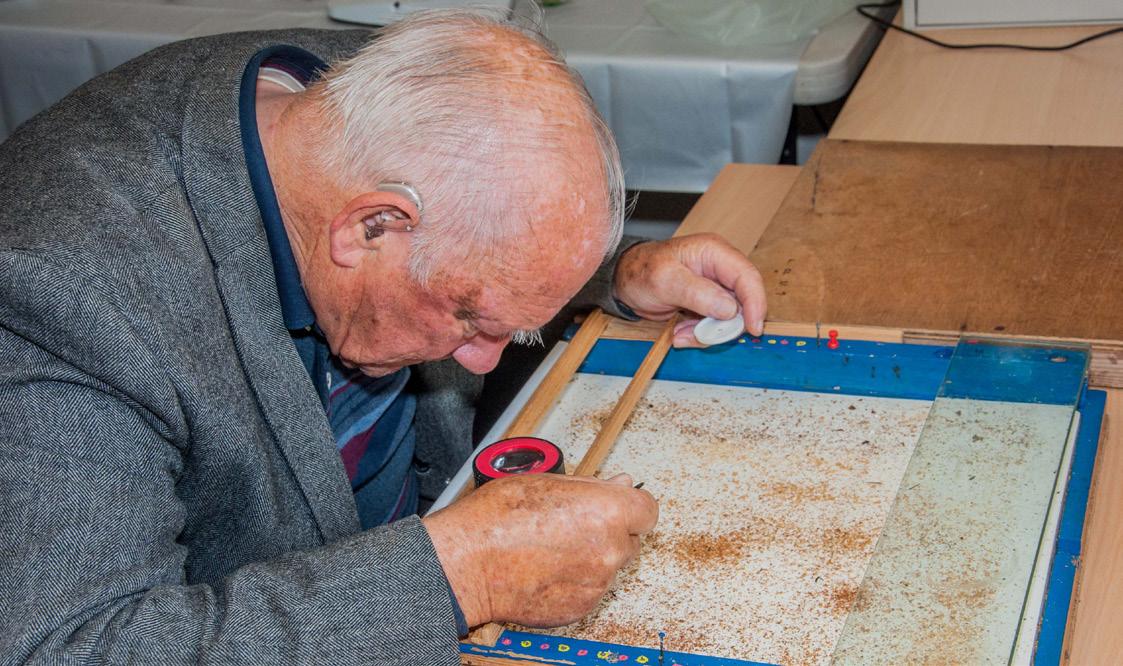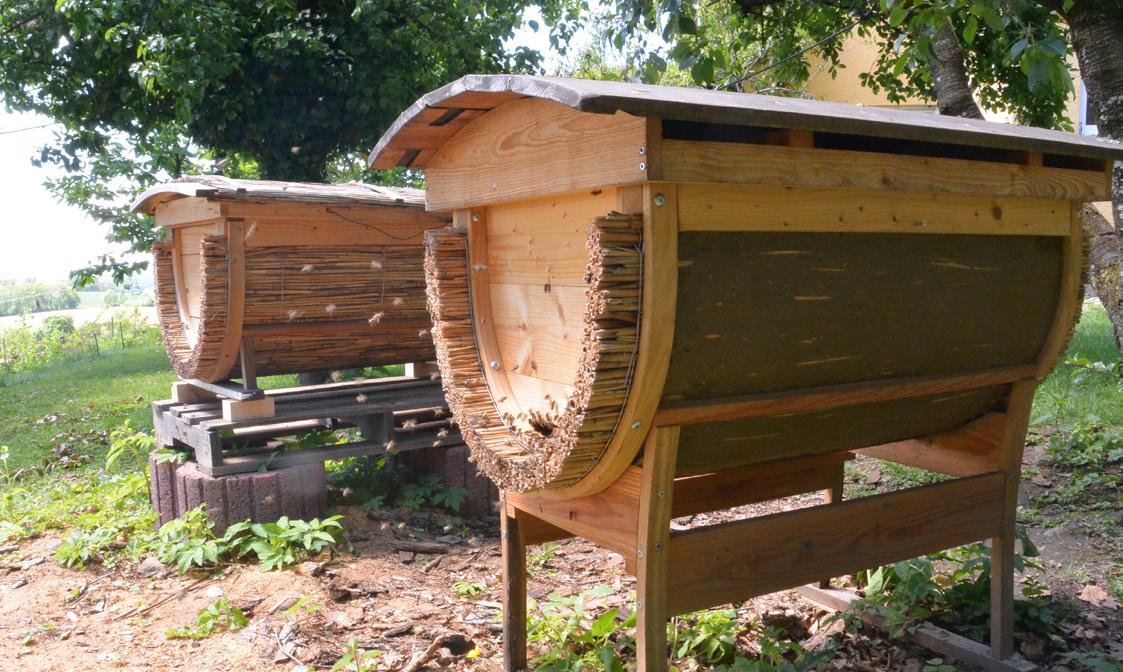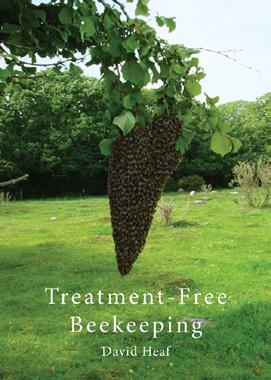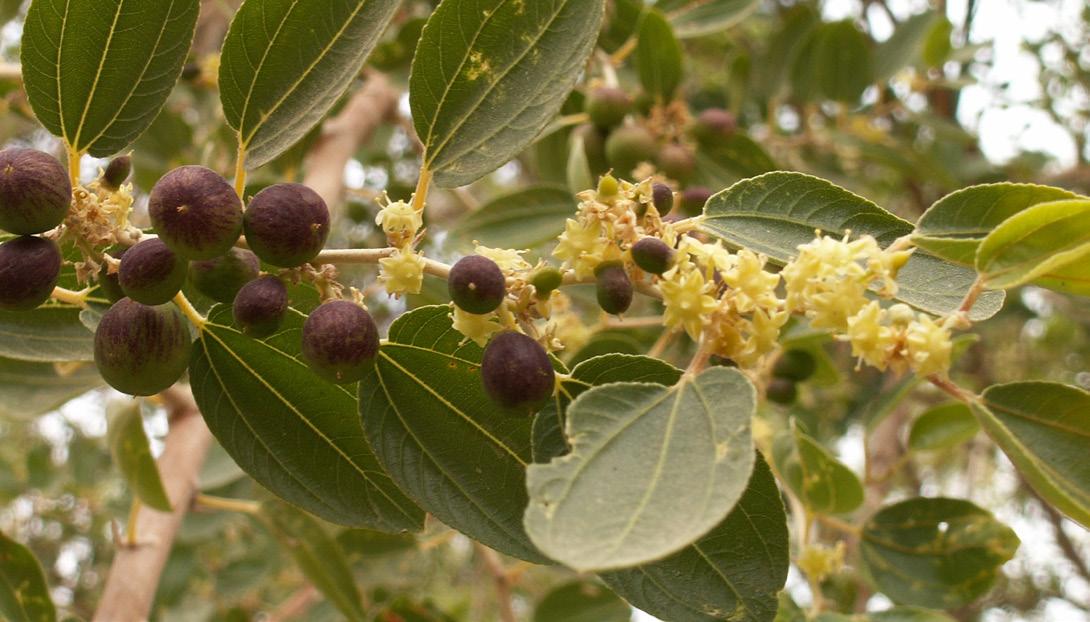
10 minute read
Uses of chemicals and why we stop using them
David Heaf, Criccieth, UK

A Warré hive apiary in a field corner. Two untreated colonies; the one on the left is over 10 years old at the time of writing (my colonies are never artificially requeened)
Chemicals used as acaricides (miticides) are in various degrees damaging to bee health. This applies as much to the commonly used organic acids and essential oils as to synthetic compounds such as pyrethroids. Acaricides variously harm drones, queens and workers throughout their development. Over the past 10 years, I have archived dozens of papers relating to this harm, with the possible intention of writing a review. With the inclusion of ‘plant protectants’, there seems to be more research done these days on bee poisoning than on their natural history, presumably due to the kind of projects that will get government and industry funding. But I recently found that the job of reviewing the deliberate poisoning by beekeepers has already been done for me by Erik Tihelka (2018) who reported on 140 scientific papers concerning the wide-ranging effects on bee health and behaviour of synthetic and organic acaricides. Some of these effects are more subtle, such as on learning behaviour, colony strength and longevity.
Chemicals and microbiomes
Tihelka also includes effects on the bee gut microbiome. The gut microbiome overwhelmingly dominates the whole bee microbiome and plays a role in metabolism, immune function, growth and development, and protection against pathogens. The honey bee microbiome is stabilised by propolis , and the colony’s propolis envelope promotes beneficial bacteria in the bee’s mouthpart microbiome, reducing pathogenic or opportunistic microbes and promoting the proliferation of putatively beneficial microbes. In view of these findings, upsetting the hive’s chemical balance by inserting, spraying in or pouring in acaricides looks very much like throwing a spanner in the works. However, even without apicultural poisons, it appears that the honey bee microbiome is somewhat compromised in agricultural environments compared with pristine environments, an example of the latter being an Adriatic island.

Ron Hoskins examining mesh floor debris for Varroa, damaged mites and pupal antennae. Ron has kept bees untreated for over 20 years, and selects for Varroa resistance with the help of the method illustrated
Another feature of using chemicals is that pests and pathogens can develop metabolic pathways that detoxify the chemicals so that those organisms become resistant to them. As far as I know there is not yet any sign of Varroa resistance to thymol or organic acid acaricides, but resistance to the synthetic pyrethroids has long been documented. Also, with their short generation times, bacteria can rapidly develop antibiotic resistance.
Increase in treatment
For Varroa, it is reported that the amount of treatment needed has increased steadily from 1980 onwards. Initially treatment (in the UK) was in winter only, then in late summer and possibly also in winter, then in late summer and definitely again in winter, and now spring, late summer and winter. These days, beekeepers are told to rotate use of acaricides, even reverting to synthetic pyrethroids and organophosphorus compounds, to keep ahead of Varroa, which, due to its short generation time, can rapidly develop resistance.
For the treatment of Nosema, the antibiotic Fumidil-B is available in the USA, but its use is not permitted in most of the EU or UK, very likely due to its genotoxicity in cytogenetic tests in vitro and in vivo. Some nonchemical ways of minimising the risk of Nosema, include a sheltered, dry and sunny hive site with a south facing entrance, minimising sugar syrup feeding, and ensuring a good rate of comb replacement should help avoid this disease of adult bees. Comb replacement is built-in to Warré hive management because new boxes are nadired* under the brood nest and honey boxes harvested from the top. I have seen only one case that was very likely due to Nosema, evidenced by bee faeces at the hive entrance, and that was in spring in a relatively weak colony in a National hive, which was the type I used before my switch to Warré hives in 2007.
Oxytetracycline (Terramycin®) antibiotic is permitted for the treatment of American and European foul brood (EFB) in the USA, subject to the production of a veterinary feed directive, a legal authorisation for antibiotics to be given to animals in feed. It may be used in the UK for EFB, although its use is less common now that shook swarming of infected colonies has been found to be more effective in the long-term. Cultivating bacterial resistance to oxytetracycline through its use in apiculture risks reducing its usefulness in human medicine.
*Nadiring means placing empty boxes under the brood nest
Chalkbrood
A common brood disease that probably every beekeeper has seen is chalkbrood, caused by the fungus Ascosphera apis. There is no chemical treatment for it. In my experience, when it comes it goes rather quickly, especially in spring, and never seriously impacts my colonies. A warm, dry and sunny hive site and good nutrition should help avoid it. In bad cases the advised treatment is requeening.
The honey bee tracheal mite Acarapis woodi was once a serious threat to apiculture in the UK, but the infestation rapidly receded to the extent that it no longer required treatments. It spread to the USA from 1980 onwards, but has since subsided considerably there too, possibly partly due to the use of acaricides for Varroa. However, it could return, especially if Varroa treatment with organic acids is stopped. The approved chemicals for treating it are based on formic acid or menthol. The sudden upsurge ofheavy colony losses in the UK at the beginning of the 20th century attributed to Acarapis, followed by the rapid decline in losses, suggests that honey bees can quickly develop resistance to mites. Afterthe appearance of naturally Varroa-resistant honey bee populations around the world, the same appears to apply to Varroa.

David Junker’s trough (horizontal) hives made of bentwood and reeds. David is a treatment-free beekeeper in southern Germany. He can be contacted via his website: kleine-holzbiegerei.de
Small hive beetle
As control of the small hive beetle (SHB) Aethina tumida is largely ineffective with chemicals, the matter of doing without poisoning them hardly arises. Colony management, cultural practices such as minimising hive opening to avoid attracting the beetle, beetle traps integrated into the hive floor (for example Beetletra), and hive entrance devices, will all help healthy colonies control the beetle. The trap can contain oil to stop the trapped beetles escaping. As with wax moth, combs that are not fully ‘policed’ by the bees, can offer a breeding environment for the beetle, so a high bee-tocomb ratio is clearly advantageous. Several excellent publications exist on dealing with SHB, a pest which at the time of writing had not reached the UK but had already spread as far as southern Italy. Australian endemic bees have fascinating defence behaviours against SHB. There is some evidence that Apis mellifera also has such abilities and can entomb SHB. Choice of hive type may also help minimise SHB proliferation. For example, the Warré hive, due to its lack of frames, has a very reduced content of internal woodenware, and therefore offers fewer places for the beetle to hide.
When I started beekeeping, I was advised by my mentor to get some paradichlorobenzene, an ingredient of mothballs, to protect my supers’ combs during winter storage. I bought a kilo from my beekeeping equipment supplier and stored it in the plastic bag in which it came, inside a metal tin with a not very tight-fitting lid. But I was discouraged from using it by its unpleasant smell, and therefore doubted it would be good for comb intended to store honey. Therefore, it sat in its tin for decades until one day I came upon the tin, empty but for a sealed polythene bag with a paradichlorobenzene label on it. Over the years, the entire kilo had sublimed through the bag! Later I realised that wax moth does not bother with combs that have not had brood in and are stored outdoors, accessible to spiders but not to mice. As regards empty brood combs left unprotected, for example not deep frozen for 48 hours to kill the moth’s eggs and then stored in a sealed bag, the moth is the organism that ends the natural cycle of the honey bee nest, reducing it to dust somewhat like compost, and freeing up the enclosure for re-occupancy and new build by a swarm.
Medication accumulation
Another matter of concern regarding hive medications is their accumulation in beeswax, honey and other hive products. Beekeepers seem to be their own worst enemy in this respect, although even if they stopped putting chemicals in their hives, there would still be the problem of the agrochemical residues which turn up in beeswax.
A further factor to consider is the ecological footprint of treating with chemicals, and their possible environmental impact. Chemicals must be manufactured in factories and distributed. Taking as an example Germany, a country in which colony registration and treatment of Varroa infestation are compulsory, thereis estimated to be about one million colonies. If all were treated only once a year with a popular formic acid treatment for Varroa, namely MAQS(strips), based on the recommendation to use two strips per hive, each containing 68.2 g formic acid, that would amount to over 120 tonnes of formic acid, a contributor to acid rain, being released into theatmosphere each year in Germany.
Comparing that figure with the estimated global release of formic acid from formicine ants of 600,000tonnes, happily the contribution from German apiculture seems small, although the contribution from apiculture globally might be more significant. Added to that is the use of oxalic acid in winter, andthere is the considerable weight of plastic packaging that must bedisposed of. Finally, the economic incentive not to treat with chemicals is worth considering. Firstly, there is the time spent treating, and therefore a cost of labour. The hobby beekeeper would be unlikely tocost this in to their beekeeping, but the sideliner, the beekeeper who earns part of their total income through beekeeping, might do so.
From Chapter 1 of Treatment Free Beekeeping by David Heaf.
Published by IBRA and NBB (2021)

Also by David Heaf: Natural beekeeping with the Warré hive and The Bee Friendly Beekeeper: a sustainable approach Translated by David Heaf: Beekeeping for all (Warré)
All four of these books are available for purchase at our webstore www.shop.beesfordevelopment.org
References
1. Heaf, D. (2021) Treatment-Free Beekeeping. Northern Bee Books, Mytholmroyd, UK.
2. Tihelka, E. (2018) Effects of synthetic and organic acaricides on honeybee health: A review. Slov Vet Res 55(2): 119-40. DOI 10.26873/SVR-422-2017.
3. Raymann K. & Moran, N. A. (2018) The role of the gut microbiome in health and disease of adult honey bee workers. Curr Opin Insect Sci. April; 26: 97–104. https://doi.org/10.1016/j.cois.2018.02.012.
4. Saelao, P., Borba, R. S., Ricigliano, V., Spivak, M. & Simone-Finstrom M. (2020) Honeybee microbiome is stabilized in the presence of propolis. Biol. Lett. 16: 20200003. http://dx.doi.org/10.1098/rsbl.2020.0003.
5. Dalenberg, H., Maes, P., Mott, B., Anderson, K. E. & Spivak, M. (2020) Propolis Envelope Promotes Beneficial Bacteria in the Honey Bee (Apis mellifera) Mouthpart Microbiome. Insects 11, 453. DOI:10.3390/insects11070453.
6. Muñoz-Colmenero, M., Baroja-Careaga, I., Kovačić, M., Filipi, J. Puškadija, Z., Kezić, N., Estonba, A., Büchler, R. & Zarraonaindia, I. (2020) Differences in honey bee bacterial diversity and composition in agricultural and pristine environments – a field study. Apidologie https://doi.org/10.1007/s13592-020-00779-w
7. Faucon, J. P., Drajnudel P. & Fléché C. (1995) Mise en évidence d’une diminution de l’efficacité de l’Apistan®; utilisé contre la varroose de l’abeille (Apis mellifera L). Apidologie 26, 291-296. https://doi.org/10.1051/apido:19950403.
8. Ritter, W. (2014) 30 Jahre Varroa-Milbe. Presentaton at Global2000 ‘Meet the Bees’ conference, Schloss Schönbrunn, Vienna, Austria, April. https:// youtu.be/VSyZzD7itdo. Slides: https://www.global2000.at/sites/global/files/Pr%C3%A4sentation%20-%20Dr.%20Wolfgang%20RITTER.pdf.
9. https://www.mannlakeltd.com/Fumidil-B-25-g?list=Category%20Listing.
10. https://britishbeevets.com/nosema/.
11. http://sciencesearch.defra.gov.uk/Document.aspx?Document=9837_VM0139_EVID_4_final_report.pdf.
12. https://britishbeevets.com/foulbrood/.
13. Moore, P. A., Wilson, M. E. & Skinner, J. A. (2015) Honey Bee Tracheal Mites: Gone? But not for Good. https://bee-health.extension.org/honey-bee-trachealmites-gone-but-not-for-good/.
14. Martin, S. J. & Grindrod, I. (2020) Natural varroa resistant honey bees – Biology, Testing and Propagation. BBKA News Special Issue Series August 2020.
15. Managing Small Hive Beetles (2019) Bee Health. https://bee-health.extension.org/managing-small-hive-beetles/
16. Halcroft, M., Spooner-Hart, R., Neumann, P. (2011) Behavioral defense strategies of the stingless bee, Austroplebeia australis, against the small hive beetle. Insectes Sociaux 58: 245-253. https://doi.org/10.1007/s00040-0100142-x. http://www.aussiebee.com.au/abol-012.html.
17. Simone-Finstrom, M. & Spivak, M. (2010) Propolis and bee health: the natural history and significance of resin use by honey bees. Apidologie 41 295–311. DOI:10.1051/apido/2010016.
18. Malfroy, T. email to warrebeekeeping@yahoogroups.co.uk, 18 August 2010.
19. Mullin, C. A., Frazier, M., Frazier, J. L., Ashcraft, S., Simonds, R., van Engelsdorp, D. & Pettis, J. S. (2010) High Levels of Miticides and Agrochemicals in North American Apiaries: Implications for Honey Bee Health. PLoS ONE 5(3): e9754. DOI:10.1371/journal.pone.0009754. http://www.plosone.org/article/info%3Adoi%2F10.1371%2Fjournal.pone.0009754.
20. https://www.gesetze-im-internet.de/bienseuchv/__15.html#Seitenanfang. 21. NOD Apiary Ireland Limited, MAQS Formic Acid 68.2g Beehive Strips for Honey Bees. Instruction leaflet.
22. Graedel, T. E. & Eisner, T. (1988) Atmospheric formic acid from formicine ants: a preliminary assessment. Tellus B: Chemical and Physical Meteorology, 40:5, 335-339. DOI:10.3402/tellusb.v40i5.15995.








